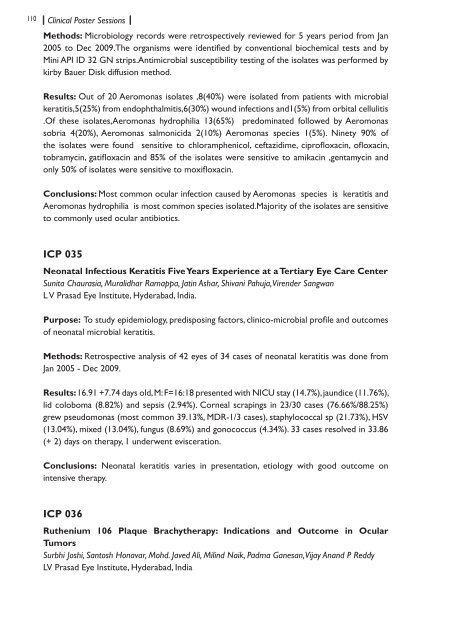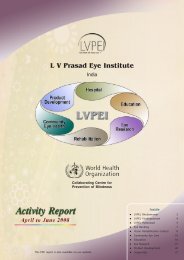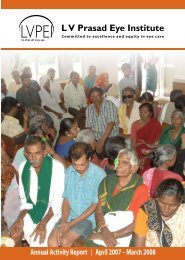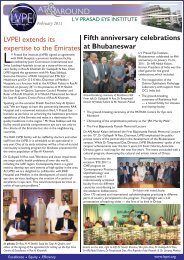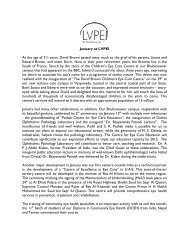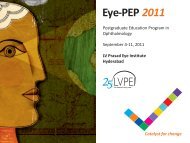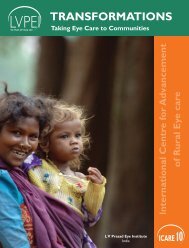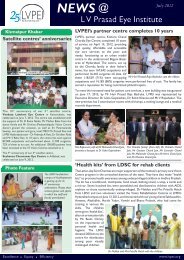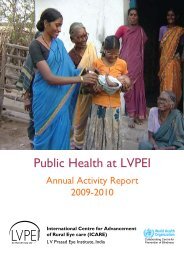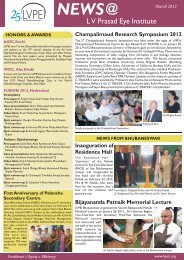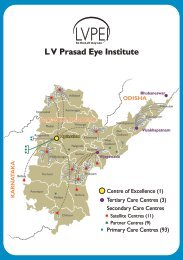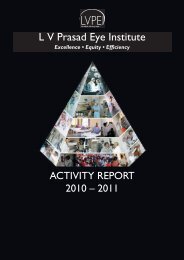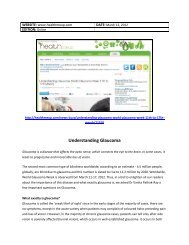IERG Abstracrt Book.indd - LV Prasad Eye Institute
IERG Abstracrt Book.indd - LV Prasad Eye Institute
IERG Abstracrt Book.indd - LV Prasad Eye Institute
Create successful ePaper yourself
Turn your PDF publications into a flip-book with our unique Google optimized e-Paper software.
110 Clinical Poster SessionsMethods: Microbiology records were retrospectively reviewed for 5 years period from Jan2005 to Dec 2009.The organisms were identified by conventional biochemical tests and byMini API ID 32 GN strips.Antimicrobial susceptibility testing of the isolates was performed bykirby Bauer Disk diffusion method.Results: Out of 20 Aeromonas isolates ,8(40%) were isolated from patients with microbialkeratitis,5(25%) from endophthalmitis,6(30%) wound infections and1(5%) from orbital cellulitis.Of these isolates,Aeromonas hydrophilia 13(65%) predominated followed by Aeromonassobria 4(20%), Aeromonas salmonicida 2(10%) Aeromonas species 1(5%). Ninety 90% ofthe isolates were found sensitive to chloramphenicol, ceftazidime, ciprofloxacin, ofloxacin,tobramycin, gatifloxacin and 85% of the isolates were sensitive to amikacin ,gentamycin andonly 50% of isolates were sensitive to moxifloxacin.Conclusions: Most common ocular infection caused by Aeromonas species is keratitis andAeromonas hydrophilia is most common species isolated.Majority of the isolates are sensitiveto commonly used ocular antibiotics.ICP 035Neonatal Infectious Keratitis Five Years Experience at a Tertiary <strong>Eye</strong> Care CenterSunita Chaurasia, Muralidhar Ramappa, Jatin Ashar, Shivani Pahuja, Virender SangwanL V <strong>Prasad</strong> <strong>Eye</strong> <strong>Institute</strong>, Hyderabad, India.Purpose: To study epidemiology, predisposing factors, clinico-microbial profile and outcomesof neonatal microbial keratitis.Methods: Retrospective analysis of 42 eyes of 34 cases of neonatal keratitis was done fromJan 2005 - Dec 2009.Results: 16.91 +7.74 days old, M: F=16:18 presented with NICU stay (14.7%), jaundice (11.76%),lid coloboma (8.82%) and sepsis (2.94%). Corneal scrapings in 23/30 cases (76.66%/88.25%)grew pseudomonas (most common 39.13%, MDR-1/3 cases), staphylococcal sp (21.73%), HSV(13.04%), mixed (13.04%), fungus (8.69%) and gonococcus (4.34%). 33 cases resolved in 33.86(+ 2) days on therapy, 1 underwent evisceration.Conclusions: Neonatal keratitis varies in presentation, etiology with good outcome onintensive therapy.ICP 036Ruthenium 106 Plaque Brachytherapy: Indications and Outcome in OcularTumorsSurbhi Joshi, Santosh Honavar, Mohd. Javed Ali, Milind Naik, Padma Ganesan, Vijay Anand P Reddy<strong>LV</strong> <strong>Prasad</strong> <strong>Eye</strong> <strong>Institute</strong>, Hyderabad, India


